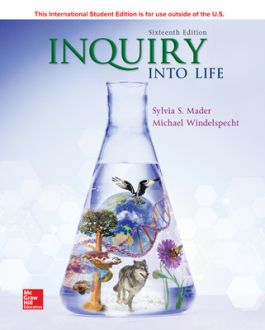Inquiry into Life ISE
16th Edition
1260568520
·
9781260568523
© 2020 | Published: May 1, 2019
Dr. Sylvia Mader’s text, Inquiry into Life, was originally developed to reach out to science-shy students. The text now represents one of the cornerstones of introductory biology education. Inquiry into Life was founded on the belief that teaching …
Read More
Request Review Access
Request More Info
After you purchase your eBook, you will need to download VitalSource Bookshelf, a free app or desktop version here. Then login or create an account and enter the code from your order confirmation email to access your eBook.
- Access the eBook anytime, anywhere: online or offline
- Create notes, flashcards and make annotations while you study
- Full searchable content: quickly find the answers you are looking for
Chapter 1 The Study of Life
Unit 1 Cell Biology
Chapter 2 The Molecules of Cells
Chapter 3 Cell Structure and Function
Chapter 4 Membrane Structure and Function
Chapter 5 Cell Division
Chapter 6 Metabolism: Energy and Enzymes
Chapter 7 Cellular Respiration
Unit 2 Plant Biology
Chapter 8 Photosynthesis
Chapter 9 Plant Organization and Function
Chapter 10 Plant Reproduction and Responses
Unit 3 Maintenance of the Human Body
Chapter 11 Human Organization
Chapter 12 Cardiovascular System
Chapter 13 Lymphatic and Immune Systems
Chapter 14 Digestive System and Nutrition
Chapter 15 Respiratory System
Chapter 16 Urinary System and Excretion
Unit 4 Integration and Control of the Human Body
Chapter 17 Nervous System
Chapter 18 Senses
Chapter 19 Musculoskeletal System
Chapter 20 Endocrine System
Unit 5 Continuance of the Species
Chapter 21 Reproductive System
Chapter 22 Development and Aging
Chapter 23 Patterns of Gene Inheritance
Chapter 24 Chromosomal Basis of Inheritance
Chapter 25 DNA Structure and Gene Expression
Chapter 26 Biotechnology and Genomics
Unit 6 Evolution and Diversity
Chapter 27 Evolution of Life
Chapter 28 Microbiology
Chapter 29 Protists and Fungi
Chapter 30 Plants
Chapter 31 Animals: The Invertebrates
Chapter 32 Animals: Chordates and Vertebrates
Unit 7 Behavior and Ecology
Chapter 33 Behavioral Ecology
Chapter 34 Population and Community Ecology
Chapter 35 Nature of Ecosystems
Chapter 36 Major Ecosystems of the Biosphere
Chapter 37 Conservation Biology
Unit 1 Cell Biology
Chapter 2 The Molecules of Cells
Chapter 3 Cell Structure and Function
Chapter 4 Membrane Structure and Function
Chapter 5 Cell Division
Chapter 6 Metabolism: Energy and Enzymes
Chapter 7 Cellular Respiration
Unit 2 Plant Biology
Chapter 8 Photosynthesis
Chapter 9 Plant Organization and Function
Chapter 10 Plant Reproduction and Responses
Unit 3 Maintenance of the Human Body
Chapter 11 Human Organization
Chapter 12 Cardiovascular System
Chapter 13 Lymphatic and Immune Systems
Chapter 14 Digestive System and Nutrition
Chapter 15 Respiratory System
Chapter 16 Urinary System and Excretion
Unit 4 Integration and Control of the Human Body
Chapter 17 Nervous System
Chapter 18 Senses
Chapter 19 Musculoskeletal System
Chapter 20 Endocrine System
Unit 5 Continuance of the Species
Chapter 21 Reproductive System
Chapter 22 Development and Aging
Chapter 23 Patterns of Gene Inheritance
Chapter 24 Chromosomal Basis of Inheritance
Chapter 25 DNA Structure and Gene Expression
Chapter 26 Biotechnology and Genomics
Unit 6 Evolution and Diversity
Chapter 27 Evolution of Life
Chapter 28 Microbiology
Chapter 29 Protists and Fungi
Chapter 30 Plants
Chapter 31 Animals: The Invertebrates
Chapter 32 Animals: Chordates and Vertebrates
Unit 7 Behavior and Ecology
Chapter 33 Behavioral Ecology
Chapter 34 Population and Community Ecology
Chapter 35 Nature of Ecosystems
Chapter 36 Major Ecosystems of the Biosphere
Chapter 37 Conservation Biology
Dr. Sylvia Mader’s text, Inquiry into Life, was originally developed to reach out to science-shy students. The text now represents one of the cornerstones of introductory biology education. Inquiry into Life was founded on the belief that teaching science from a human perspective, coupled with human applications, would make the material more relevant to the student. This text, along with the Inquiry Into Life 15.1 edition, represent an ongoing project in the development of a continuously-updated textbook. As scientists and educators, the authors of this text are well aware that scientific discovery is a dynamic process. Fortunately, the advances in digital publishing are allowing authors to update content on an ongoing basis, which in turn is promoting the ability to update content on a regular basis. This text represents the prototype of those efforts
.

